Long-Term Budget Outlook: Fiscal Implications of the Government’s Program Reforms: 2020-2050

The report provides a forecast of Ontario’s economy and fiscal position through 2050, based on current fiscal policies.
Long-Term Budget Outlook: Fiscal Implications of the Government’s Program Reforms: 2020-2050, Financial Accountability Office of Ontario, 2020.

